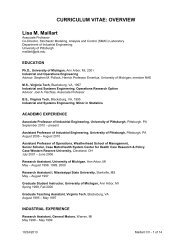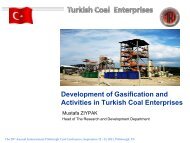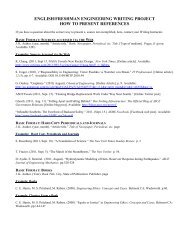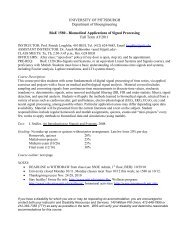Abstract Booklet 2006 - Swanson School of Engineering - University ...
Abstract Booklet 2006 - Swanson School of Engineering - University ...
Abstract Booklet 2006 - Swanson School of Engineering - University ...
You also want an ePaper? Increase the reach of your titles
YUMPU automatically turns print PDFs into web optimized ePapers that Google loves.
5-5<br />
Enhanced Hydrogen Production with in-situ CO 2 Capture<br />
in a Single Stage Reactor<br />
Liang-Shih Fan, Mahesh Iyer, Shwetha Ramkumar, Danny Wong, The Ohio State<br />
<strong>University</strong>, USA<br />
Enhancement in the production <strong>of</strong> high purity hydrogen from fuel gas, obtained from coal<br />
gasification, is limited by thermodynamics <strong>of</strong> the Water Gas Shift Reaction which is used to<br />
shift the carbon monoxide towards hydrogen. However, this constraint can be overcome by<br />
concurrent water-gas shift (WGS) and carbonation reactions to enhance H 2 production by<br />
incessantly driving the equilibrium-limited WGS reaction forward and removing the CO 2<br />
product from the fuel gas mixture in-situ. This not only improves the H 2 yield but also<br />
augments the purity <strong>of</strong> the product by removing the CO 2 co-product and achieving near<br />
complete conversion <strong>of</strong> the CO reactant. This process developed at the Ohio State <strong>University</strong><br />
can effectively and economically produce a pure H 2 stream, at high temperature and<br />
pressure, via coal gasification while integrating capture <strong>of</strong> CO 2 emissions, for its subsequent<br />
sequestration. The enhanced water gas shift reaction for H 2 production with insitu<br />
carbonation was studied using the commercial High Temperature Shift (Iron Oxide) catalyst<br />
and calcium sorbents in an integral fixed bed reactor setup. We have identified a high<br />
reactivity patented, mesoporous calcium oxide sorbent for the in-situ CO 2 capture. The<br />
morphological properties <strong>of</strong> our patented precipitated calcium carbonate sorbent (PCC) can<br />
be tailored using surface modifiers to demonstrate a high CO 2 capture capacity <strong>of</strong> about 70%<br />
by weight (~700g <strong>of</strong> CO 2 /kg sorbent ) at elevated temperatures (600-700°C). Experimental<br />
evidence clearly shows that this proprietary calcium sorbent (PCC) performance dominates<br />
over that <strong>of</strong> commercial limestone sorbents at any given time. Thus, product gas<br />
composition analyses demonstrate complete carbon monoxide conversion as well as CO 2<br />
removal during the initial part <strong>of</strong> the breakthrough curve, thus demonstrating the synthesis <strong>of</strong><br />
pure hydrogen.<br />
6-1<br />
SESSION 6<br />
GLOBAL CLIMATE CHANGE:<br />
GEOLOGIC CARBON SEQUESTRATION – 1<br />
Effects <strong>of</strong> CO 2 and Aquifer Brine on Well Plugging Cements<br />
Steve Gerdemann, G.E. Rush, Bill O’Connor, NETL, USA<br />
General consensus is that CO 2 at injection pressures in a saline environment will degrade<br />
portland based well plugging cements. Long term exposure, years or decades are typical<br />
time frames mentioned and modeled. Actual cement samples from CO 2 environments such<br />
as oil fields in which CO 2 has been used to extend field production are rare, and actual<br />
brackish to saline aquifer rock with CO 2 exposure still less common. Laboratory experiments<br />
to simulate the saline environments were run with interesting results.<br />
6-2<br />
Using Pinnate Well Patterns for CO 2 Sequestration in<br />
Allison Unit Reservoir Simulation Study<br />
Jalal Jalali, Shahab Mohaghegh, West Virginia <strong>University</strong>, USA<br />
Concerns about rising concentrations <strong>of</strong> carbon dioxide (CO 2 ) in the atmosphere and the<br />
necessity <strong>of</strong> reducing greenhouse gas emissions has led to consideration <strong>of</strong> large-scale<br />
storage <strong>of</strong> CO 2 in subsurface. Carbon dioxide is injected into unminable coal seams for<br />
enhancing the coalbed methane recovery, which also has the extra advantage <strong>of</strong> long-term<br />
CO 2 sequestration. Pilot projects exist in North America and some European countries to<br />
study the feasibility <strong>of</strong> CO 2 sequestration in depleted oil and gas reservoirs.<br />
Among different well patterns currently used for primary recovery <strong>of</strong> coalbed methane,<br />
horizontal pinnate wells demonstrate high methane recovery in a short period <strong>of</strong> time along<br />
with cost reductions and smaller footprints.<br />
In this study, a pinnate well is first used for primary recovery <strong>of</strong> methane and then converted<br />
into an injector for CO 2 injection to enhance the methane recovery and eventually long term<br />
sequestration. The large contact area between the wellbore and the formation helps fast<br />
dewatering, hence producing the methane, which is desorbed from the coal matrix into the<br />
natural fractures. The pinnate pattern distributes the CO 2 in a large area <strong>of</strong> the formation<br />
before it reaches the producing wells. Therefore, a larger amount <strong>of</strong> CO 2 could be stored in<br />
the formation before CO 2 breakthrough occurs.<br />
In this paper, a feasibility study <strong>of</strong> CO 2 sequestration using pinnate patterns into a coal seam<br />
in the Allison Unit is presented. Several characteristics <strong>of</strong> the pinnate pattern and the CO 2<br />
injection strategy are studied and optimized using a numerical reservoir simulator in order to<br />
increase the methane recovery and total CO 2 that can be stored before breakthrough. Results<br />
will be compared with the results from the well pattern currently used for CO 2 flooding in<br />
the field.<br />
6-3<br />
Experimental Measurements <strong>of</strong> the Solubility <strong>of</strong> CO 2 in<br />
the Oriskany Sandstone Aquifer<br />
Robert M. Dilmore, Patrice Pique, Sheila Hedges, Yee Soong, R. J. Jones,<br />
DOE/NETL, USA<br />
5<br />
Douglas Allen, DOE/NETL, Salem State College, USA<br />
Experiments were conducted to determine the solubility <strong>of</strong> CO 2 in a natural brine<br />
solution <strong>of</strong> the Oriskany sandstone formation under elevated temperature and pressure<br />
conditions. These data were collected at pressures between 100 and 450 bars and at<br />
temperatures <strong>of</strong> 21 and 75ºC. In addition, data on CO 2 solubility in pure water were<br />
collected over the same pressure range as a means <strong>of</strong> verifying reliability <strong>of</strong><br />
experimental technique. Experimentally determined data were compared with CO 2<br />
solubility predictions using a model developed by Duan and Sun (2003). Model results<br />
compare well with Oriskany brine CO 2 solubility data collected experimentally,<br />
suggesting that the Duan and Sun model is a reliable tool for estimating solution CO 2<br />
capacity in high salinity aquifers in the temperature and pressure range evaluated.<br />
6-4<br />
Evaluation <strong>of</strong> CO 2 Flood on the Geomechanics <strong>of</strong> Whole Core Samples<br />
Steve Gerdemann, Hank Rush, Bill O'Connor, NETL, USA<br />
Geological sequestration <strong>of</strong> CO 2 , whether by enhanced oil recovery (EOR), coal-bed<br />
methane (CBM) recovery, or saline-aquifer injection, is a promising near-term sequestration<br />
methodology. While tremendous experience exists for EOR, and CBM recovery has been<br />
demonstrated in existing fields, saline-aquifer-injection studies have only recently been<br />
initiated. Studies evaluating the availability <strong>of</strong> saline aquifers suitable for CO 2 injection show<br />
great potential.<br />
This study evaluated the physical and chemical effects on Mt. Simon sandstone core from<br />
the Illinois Basin exposed to simulated deep-aquifer brine saturated with super-critical CO 2 .<br />
Conducting these tests on whole core samples rather than crushed core allowed an<br />
evaluation <strong>of</strong> the impact <strong>of</strong> the CO 2 flood on the rock-mechanics properties as well as the<br />
geochemistry <strong>of</strong> the core and brine solution. Preliminary results show an increase in porosity<br />
and a decrease in crushing strength <strong>of</strong> the core after exposure to CO 2 for 2000 hours.<br />
6-5<br />
Sequestration <strong>of</strong> CO 2 in Mixtures <strong>of</strong> Bauxite Residue and Saline Waste Water<br />
with Carbonate Mineral Formation and Caustic Byproduct Neutralization<br />
Robert Dilmore, Yee Soong, Sheila Hedges, Angelo Degalbo, DOE/NETL, USA<br />
Douglas Allen, DOE/NETL, Salem State College, USA<br />
Jaw K. Fu, Charles L. Dobbs, ALCOA, USA<br />
Chen Zhu, Indiana <strong>University</strong>, USA<br />
Under consideration is a process designed to enhance the CO 2 trapping capacity <strong>of</strong><br />
brine solutions through addition <strong>of</strong> bauxite residue with subsequent carbonation <strong>of</strong> the<br />
caustic mixture. A set <strong>of</strong> experiments was conducted to explore the concept <strong>of</strong> utilizing<br />
mixtures <strong>of</strong> bauxite residue and brine to sequester carbon dioxide from industrial gas<br />
streams such as flue gas from coal fired electric utility boilers. Factors affecting the<br />
solubility <strong>of</strong> acid gasses in such mixtures include temperature, pressure, and water<br />
chemistry properties including pH, ionic concentration, and salinity. Bauxite<br />
residue/brine mixture <strong>of</strong> 90/10 by volume exhibited a CO 2 sequestration capacity <strong>of</strong><br />
greater than 9.5 grams per liter when exposed pure CO 2 at 20ºC and 100 psig. Calcite<br />
formation was verified as a product <strong>of</strong> bauxite/brine mixture carbonation. Data<br />
presented herein provide a preliminary assessment <strong>of</strong> overall process feasibility and<br />
probe the influence <strong>of</strong> several variables on treatment efficiency. It is demonstrated that<br />
CO 2 sequestration is augmented by adding bauxite residue as a caustic agent to acidic<br />
brine solutions, and that trapping is accomplished through solubilization and ultimate<br />
mineralization.<br />
SESSION 7<br />
GASIFICATION TECHNOLOGIES:<br />
APPLICATIONS AND ECONOMICS – 2<br />
7-1<br />
The Shell Coal Gasification Process<br />
Hugo T. P. Bos, F.G. van Dongen, Shell Global Solutions International BV, THE<br />
NETHERLANDS<br />
The latest status <strong>of</strong> the Shell Coal gasification Process (SCGP) is discussed.<br />
Applications <strong>of</strong> gasification for chemicals production and power production are given.<br />
Projects throughout the world are presented including the status <strong>of</strong> completion/ startup.<br />
The latest developments <strong>of</strong> the Shell Coal gasification Process are presented such as<br />
combined oil + coal gasification, biomass/coal to liquids conversion and methods for<br />
CO 2 sequestration.<br />
7-2<br />
The GSP Gasification Process; State-<strong>of</strong>-the-Art and Further Development<br />
Manfred Schingnitz, Klaus-Dieter Klemmer, Future Energy GmbH, GERMANY<br />
The development <strong>of</strong> the GSP-Process, a pulverized fuel pressure gasification technology,<br />
was started in 1975 by Deutsches Brennst<strong>of</strong>finstitut Freiberg/Sa. (DBI, German Fuel<br />
Research Institute). Main objective for this development was the demand to save crude oil














